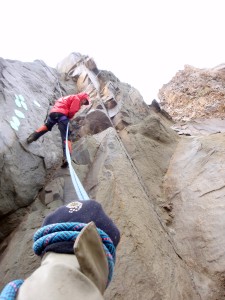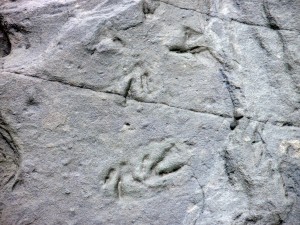Tracks show dinosaurs roamed Alaska in Jurassic Period
December 14, 2010

Theresa Bakker
907-474-6941
12/14/10
Until last summer, recent discoveries of dinosaur bones and tracks in Alaska have been restricted to the Cretaceous Period.
That changed when a team including University of Alaska Fairbanks scientists documented fossilized tracks in Southwest Alaska that appear to date from the Jurassic Period, which stretches from 150 to 200 million years ago.
“In one fell swoop we pushed the record of dinosaurs in Alaska back about 50 million years,” said Patrick Druckenmiller, earth sciences curator at the University of Alaska Museum of the North and assistant professor in the UAF geology and geophysics department.
In 1975, geologists mapping the rocks near Chignik Bay discovered what appeared to be three-toed dinosaur tracks on a sandstone cliff. The group photographed the site but did not collect any other data. Thirty-five years later, Druckenmiller and a team of scientists set out to find the location in that photo and fully document the site. The team included Kevin May from the museum, UAF geologists Sarah Fowell and Paul McCarthy, and invertebrate paleontologist Robert Blodgett of Anchorage.

Planning the expedition presented logistical challenges. The field area is in remote and mountainous terrain famous for its high density of coastal brown bears. The precise location of the tracks was also uncertain, so Druckenmiller received permission to work on both Chignik Lagoon Native Corporation land and in the Alaska Peninsula National Wildlife Refuge. The work was based out of Chignik Bay, Alaska.
“It was great to land in a community that was very receptive and accommodating to the field work we had to do,” said Druckenmiller.
Supported by helicopter pilot Sam Egli of King Salmon, the team established a remote field camp and set to work. May said they found the site after only two days of searching. “After staring at the 1975 photograph for so long, it was a real thrill to finally see it in real life.”
The layer of tracks was tilted nearly vertically and could only be reached with the use of climbing equipment. Once they reached the site, Druckenmiller and May made replicas of each track for study and exhibit back at the museum.
Druckenmiller said the trip netted a surprising amount of information.
“Based on their size and shape we can tell that the tracks were made by a human-sized, meat-eating (theropod) dinosaur,” he said. “We could even see impressions from tips of their claws. That makes these tracks especially rare.”
The rest of the team examined the rocks for additional clues and were able to establish that these dinosaurs walked on sand in a beach-type environment during the Late Jurassic Period, long before modern Alaska took shape.
Druckenmiller said the findings provide an entirely new chapter in the story of the life that once existed in Alaska and he hopes to return to the site in the near future. “We are pretty sure there are other surprises waiting for us out there.”
ADDITIONAL CONTACTS: Patrick Druckenmiller, museum earth sciences curator, 907-474-6954, psdruckenmiller@alaska.edu.
ON THE WEB: museum.uaf.edu
NOTE TO EDITORS: Images of the dinosaur tracks and the fieldwork team are available for download at www.uafnews.com.
TB/12-14-10/113-11


